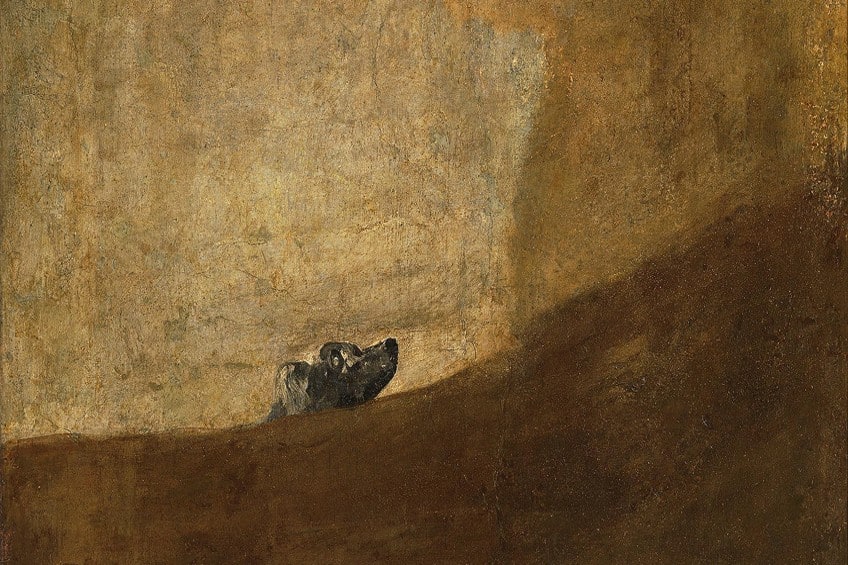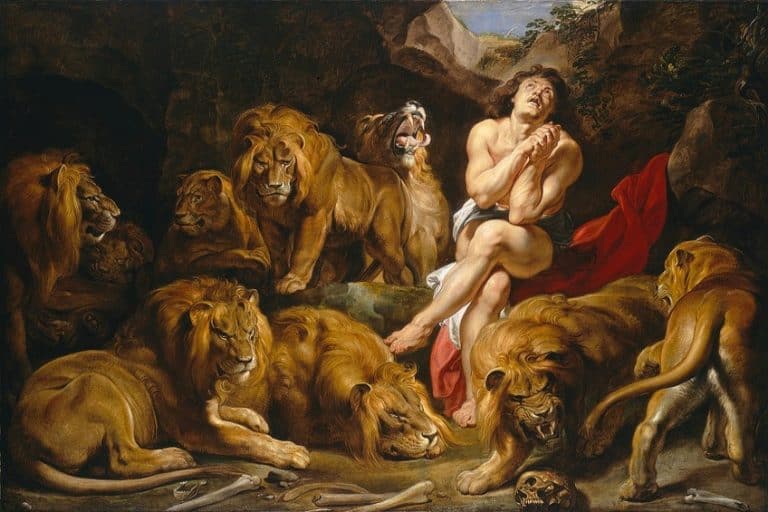“The Dog” by Francisco Goya – The Symbolism Behind the Artwork
The Dog, painted by Francisco Goya between 1819 and 1823, stands as a poignant testament to the human condition amidst turmoil and uncertainty. As one of his renowned Black Paintings, executed directly onto the walls of his home, Quinta del Sordo, this haunting masterpiece captures the essence of existential dread and despair. The solitary figure of the dog, illuminated by an eerie, almost spectral light against a backdrop of shadowy darkness, embodies a universal symbol of human vulnerability and isolation. Goya’s enigmatic portrayal invites viewers into a realm where raw emotion transcends the boundaries of time and space, compelling introspection and dialogue about the complexities of the human psyche. Through this analysis, we delve into the layers of meaning behind Goya’s enigmatic brushstrokes, exploring themes of mortality, solitude, and the precariousness of existence in the face of adversity.
Key Takeaways
- The Dog by Francisco de Goya is an emotionally charged painting that portrays a lone dog with an expansive empty space above it.
- Originally a mural in Goya’s home and part of the Black Paintings, the work is now displayed at the Museo Nacional del Prado after being transferred to canvas.
- The painting is a significant piece of art history, reflecting Goya’s personal turmoil and considered pioneering for its Symbolist elements.
Historical Context
| Artist | Francisco Goya (1746 – 1828) |
| Date Created | Circa 1819 – 1823 |
| Medium | Oil on canvas |
| Genre | Portraiture and animal painting |
| Period/Movement | Romanticism |
| Dimensions (cm) | 131.5 x 79.3 |
| Series/Versions | N/A |
| Where Is It Housed? | Museo del Prado, Madrid, Spain |
| What It Is Worth | Estimated to be priceless, in terms of cultural and historical significance. |
The Dog is one of the most enigmatic and intriguing paintings by the Spanish artist Francisco de Goya. Created between 1819 and 1823, this artwork is remarkable for its simplicity and emotional depth. Residing in the Museo Nacional del Prado in Madrid, this painting features the head of a small dog, seemingly gazing upwards. The composition is stark, with a vast majority of the canvas dominated by an expanse of space, engendering a sense of isolation and curiosity about the dog’s circumstances and surroundings.
The painting is part of a series of works known as the Black Paintings, which Goya painted directly onto the walls of his house.
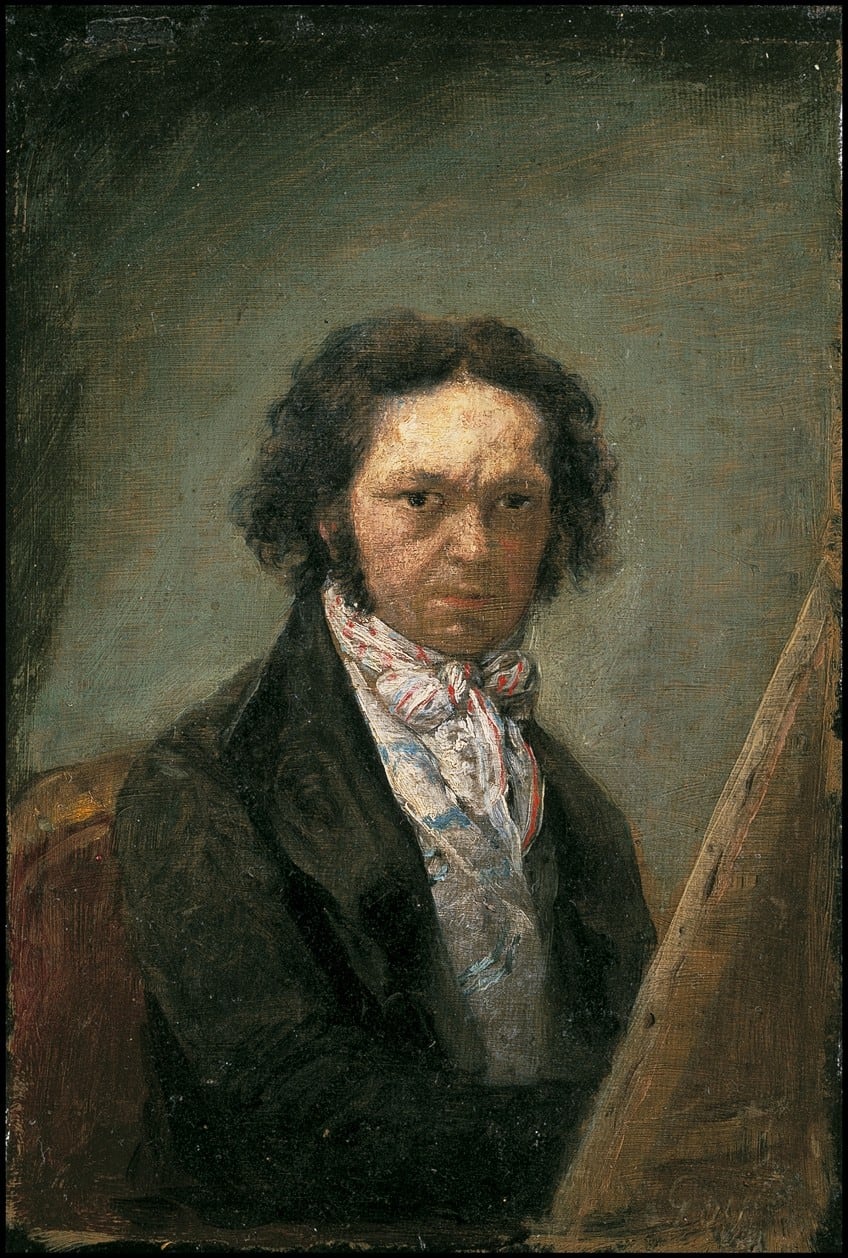
These murals have been recognized for their dark, introspective qualities and marked a significant period in the artist’s life where he was believed to grapple with his fears and personal struggles. For its aura of mystery and minimalistic execution, The Dog is often cited as an early example of Symbolist art. Through time, the artwork has undergone restoration, its original form being a mural transposed onto canvas, ensuring its survival and continued appreciation by future generations.
The Black Paintings and Quinta del Sordo
The Dog is part of a group known as the Black Paintings, a series of fourteen works that Francisco Goya painted directly onto the walls of his country house, known as Quinta del Sordo (Deaf Man’s Villa), near Madrid. Created during the later years of his life, around 1819–1823, these paintings reflect a dark and introspective period for Goya, who was no longer Spain’s court painter. The Black Paintings were not intended for public display; instead, they seemed to be a personal outpouring of Goya’s emotions as Spain was in turmoil due to political unrest and civil conflict.
After Goya’s death, the murals, including The Dog, were transferred to canvas and later became part of the collection at the Museo Nacional del Prado in Madrid.
The Creation of The Dog
The Dog, known in Spanish as “El Perro” and sometimes referred to as “Head of a Dog” or “The Dog Painting,” stands out among the Black Paintings for its minimalistic yet powerful representation. The oil mural, originally painted on plaster and later transferred to canvas through a process initiated by Baron Émile d’Erlanger, depicts a dog only seen from the neck up, with a vast, ambiguous space around it, leading to interpretations of enigmatic, despair, and drowning.

Antonio Saura, a 20th-century Spanish artist, and Joan Miró, a fellow painter and compatriot, have cited the profound influence of Goya’s Black Paintings on their work, highlighting the enduring legacy of The Dog. The artwork’s emotional potency has been interpreted as a manifestation of Goya’s mental and physical distress during its creation, resonating a sense of isolation as the dog peers into the unknown.
Formal Analysis
The painting The Dog by Francisco de Goya is noted for its minimalistic composition and profound emotional impact. This section provides a formal analysis, examining its symbolism, artistic composition, and current display parameters.
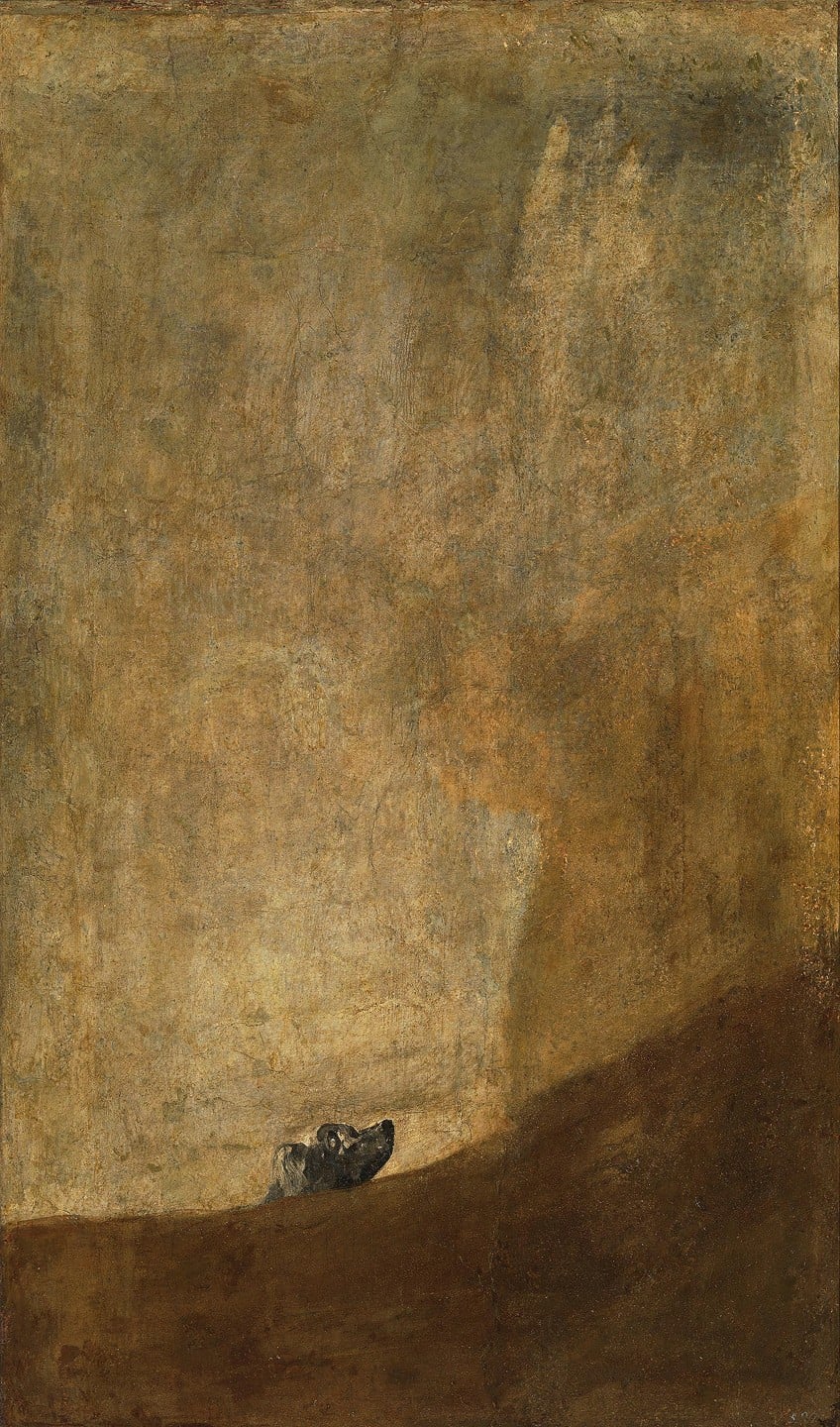
Symbolism and Interpretation
The half-submerged dog depicted in Goya’s painting is often seen as an embodiment of desolation and neglect. While some interpret the dog as fighting against death and acute mental and physical distress, others view it as a poignant representation of hope, with the dog looking towards something beyond the canvas.
The interpretation of this artwork has varied widely, with notable artists like Antonio Saura and Joan Miró finding inspiration in its ambiguous narrative.
Composition and Style
Goya’s style in this piece is markedly minimalist, with bold contrasts between the background and the foreground. The foreground presents an expansive, empty landscape while the background, characterized by a dark, formless mass, accentuates the isolation of the dog. The painting was part of a series known as the Black Paintings, created on the walls of his house and later transferred to canvas using a special process. Goya used oils to achieve the textural variance that captivates viewers.
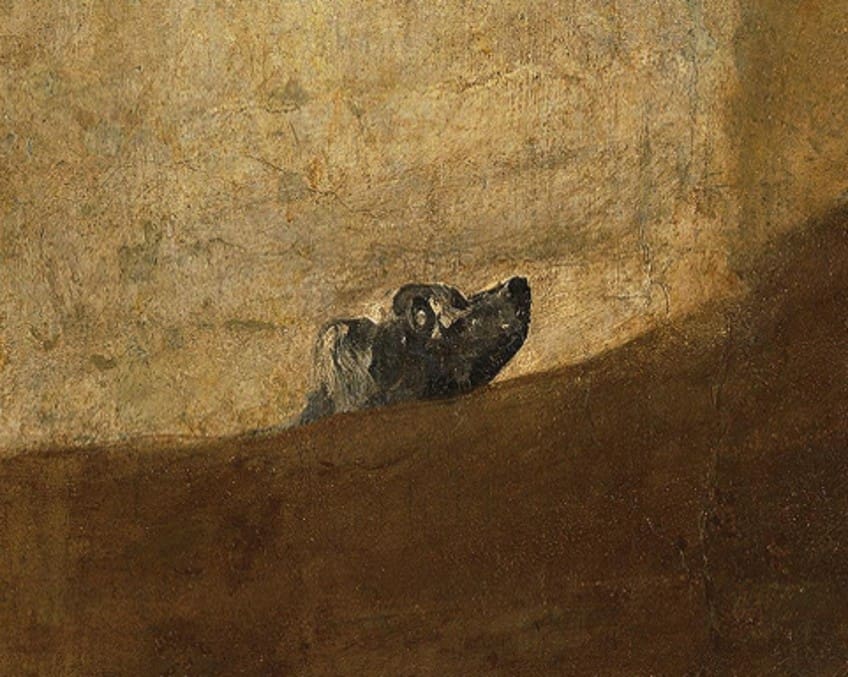
Dimensions and Display
The Dog is characterized by dimensions that enhance its stark impact, measuring 131.5 cm in height and 79.3 cm in width. This ratio creates an elongated vertical space, intensifying the sense of confinement within the painting. Now housed in the Museo del Prado, the artwork is displayed as part of a public exhibition.
Painted during the artist’s mid-70s, The Dog surpasses the age and reflective tone of his other famous works such as La Maja Desnuda, serving as a defining image of Goya’s later years in Bordeaux.
Restoration Efforts
The Dog, a painting by esteemed Spanish artist Francisco de Goya, underwent significant restoration to preserve its integrity. In the mid-70s, Baron Émile d’Erlanger played a crucial role in the preservation efforts. Originally part of a larger series known as the Black Paintings, The Dog was painted on the walls of Goya’s home near Madrid. Due to the delicate nature of the murals, the transfer process to canvas was a critical point in the artwork’s history.
In 1873, Baron Émile d’Erlanger acquired la Quinta, where the paintings, including The Dog by Francisco Goya, were originally housed. The following year, in 1874, the paintings were transferred to canvas, ensuring their preservation.
Finally, in 1881, the entire collection, including The Dog, was generously donated to the State, securing its place in the public sphere for future generations to appreciate and contemplate. During the transfer, the painting suffered drastically, losing a substantial amount of paint. Despite these challenges, the artwork was successfully relocated to the Museo del Prado in Madrid.

The Prado Museum has facilitated the painting’s public exhibition. Through their meticulous conservation work, The Dog remains a testament to Goya’s artistic prowess and an invaluable piece of cultural history. It shares a space with other distinguished works like La Maja Desnuda, ensuring that viewers appreciate the evolution of Goya’s artistry, from his courtly portraits to his haunting later works, like those completed in his solitude in Bordeaux.
The Dog in Art History
The Dog, a famed painting by Francisco de Goya, showcases a solitary head of a dog emerging against an expansive, overwhelming backdrop. This artwork stands as a poignant example of Goya’s late style and a precursor to modern symbolism.
Influence and Legacy
Francisco de Goya’s painting, commonly referred to as El Perro or The Dog, is a singular piece of art that has captivated audiences and influenced artists since its creation. Completed between 1819 and 1823, this artwork is part of Goya’s acclaimed Black Paintings series, which were originally painted directly onto the walls of his home.
The Dog assumes a special place within this series due to its minimalist composition and the emotional depth conveyed through the dog’s subtle gaze.
The provenance of The Dog traces back to Baron Émile d’Erlanger, who, after acquiring Goya’s Quinta del Sordo estate in 1873, initiated the transfer of the murals, including this piece, from the walls to canvas, a process which allowed these works to be preserved and exhibited. As the paintings transitioned into the public eye, their impact on art history became more pronounced.
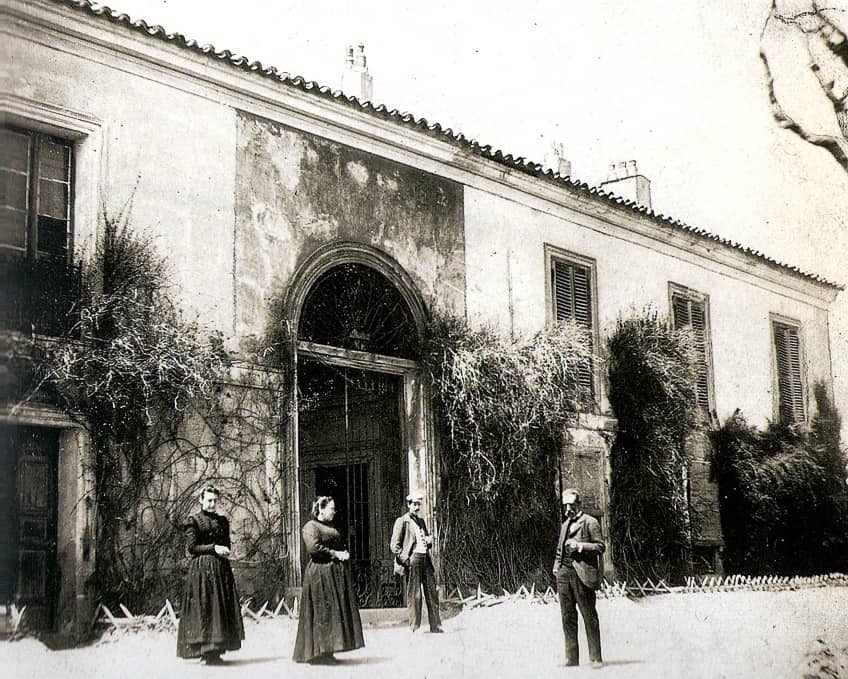
The Dog’s legacy lies in its ability to foreshadow the emotional and existential themes that would later be explored in the Symbolist movement. Its stark presentation of subject evokes a sense of isolation and introspection that resonates with audiences, marking its place as an antecedent to modernist concerns. As it hangs in the Museo del Prado in Madrid, it continues to influence generations, underscoring the poignancy and enduring relevance of Goya’s later works.
Francisco Goya’s The Dog encapsulates the profound essence of human experience through its stark imagery and emotive intensity. Its timeless power lies in its ability to provoke contemplation on life’s fragility and the universal struggle against existential uncertainty. Goya’s masterful manipulation of light and shadow, coupled with the palpable sense of isolation, invites viewers into a dialogue about the human condition. Through this painting, we confront our own complexities with courage and empathy, finding solace in art’s ability to connect us across time and space.
Frequently Asked Questions
What Is the Significance Behind Francisco Goya’s The Dog?
The Dog by Francisco Goya is considered one of the most enigmatic artworks in the Black Paintings series. This painting, housed in the Museo del Prado, is often interpreted as a reflection on isolation, despair, or the inevitability of death. The minimalistic composition, featuring the head of a dog looking upwards, evokes a sense of emotional depth and resonance.
How Does The Dog Compare to Other Works in Goya’s Black Paintings Series?
Compared to other pieces in the Black Paintings series, The Dog stands out for its simplicity and almost abstract quality. Whereas other paintings in the series often depict intense, dark themes with groups of figures, The Dog presents a stark contrast with its solitary subject and vast empty space, provoking a different kind of contemplation about human existence and its challenges.
Isabella studied at the University of Cape Town in South Africa and graduated with a Bachelor of Arts majoring in English Literature & Language and Psychology. Throughout her undergraduate years, she took Art History as an additional subject and absolutely loved it. Building on from her art history knowledge that began in high school, art has always been a particular area of fascination for her. From learning about artworks previously unknown to her, or sharpening her existing understanding of specific works, the ability to continue learning within this interesting sphere excites her greatly.
Her focal points of interest in art history encompass profiling specific artists and art movements, as it is these areas where she is able to really dig deep into the rich narrative of the art world. Additionally, she particularly enjoys exploring the different artistic styles of the 20th century, as well as the important impact that female artists have had on the development of art history.
Learn more about Isabella Meyer and the Art in Context Team.
Cite this Article
Isabella, Meyer, ““The Dog” by Francisco Goya – The Symbolism Behind the Artwork.” Art in Context. February 20, 2024. URL: https://artincontext.org/the-dog-by-francisco-goya/
Meyer, I. (2024, 20 February). “The Dog” by Francisco Goya – The Symbolism Behind the Artwork. Art in Context. https://artincontext.org/the-dog-by-francisco-goya/
Meyer, Isabella. ““The Dog” by Francisco Goya – The Symbolism Behind the Artwork.” Art in Context, February 20, 2024. https://artincontext.org/the-dog-by-francisco-goya/.


